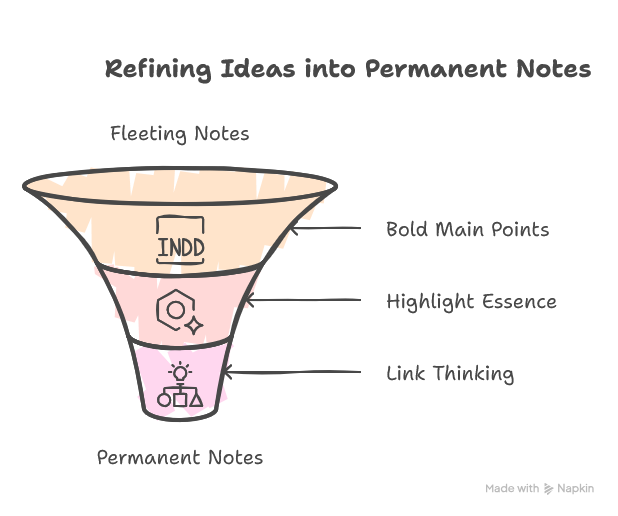A common question in the world of Personal Knowledge Management (PKM), especially when using a Zettelkasten, is: how do you decide which notes to keep? In this post, I’ll share my approach to curating notes for your Zettelkasten.
From a Zettelkasten perspective, this process begins when you capture ideas, whether from external sources or your own thoughts, as you build your Zettelkasten system.
The power of fleeting notes: Capture everything of interest
As I’ve discussed in my post “The essential guide to managing fleeting notes for productivity and knowledge management“, fleeting notes are essential for effective knowledge management.
Examples of fleeting notes include:
- Highlights from books
- Quotes from articles or podcasts
- Your own spontaneous ideas
The key takeaway: Externalise your thoughts and ideas before they disappear.
Think of fleeting notes as the raw ingredients, ready to be processed by your mind and Zettelkasten to create new knowledge.
Send your fleeting notes to an inbox for later processing.
Progressive Summarisation: Distilling the Essence
I use progressive summarisation throughout my Zettelkasten process, based on Tiago Forte’s method in his YouTube video, “Tiago Forte, Highlighting 2.0: Hacking Your Digital Notes“.
Tiago Forte’s method involves:
- Saving excerpts that resonate with you – those that are interesting, useful, potential, or surprising.
- Bolding the main points and key ideas within those excerpts.
- Highlighting the most important parts of the bolded sections.
While Tiago Forte explains the concept brilliantly, it doesn’t perfectly align with the Zettelkasten methodology. Here’s how I adapt it:
1. Create fleeting notes: Capture any ideas that resonate with you – those that are interesting, useful, potential, or surprising. This is similar to saving excerpts in Tiago’s system.”
2. Bold the main points: Before creating literature notes, review your fleeting notes and highlight the key insights.
3. Highlight the essence: I do this twice: first, when creating literature notes with a bullet-pointed summary of the highlighted sections of my fleeting notes; and second, when creating permanent notes.
4. Linking your thinking: When creating permanent notes, consider how the ideas relate to your existing knowledge and other notes.
This process helps you learn by revisiting ideas and considering how they fit with your existing knowledge within your Zettelkasten.

Don’t underestimate the Fleeting note!
Remember: Fleeting notes are the starting point of knowledge creation! Capture your own ideas and those of others that resonate with you, without judgment.
Set aside time regularly to review your fleeting notes and decide on the next steps.
For my own ideas, I decide whether to turn them into permanent notes directly, skipping the literature note stage. If I create a permanent note, I consider how it fits with my existing knowledge and link it to relevant notes.
Ideas from others are either added to my list for further processing or archived.
At any stage, I might decide not to process a note further, in which case the fleeting note is archived.
The final stage of processing fleeting notes from external sources is creating literature notes.
You might think this process could be more efficient, and you’d be right. However, the friction helps deepen my understanding and encourages reflection, which in turn aids my learning.
Join my weekly newsletter to stay updated with my latest content.
